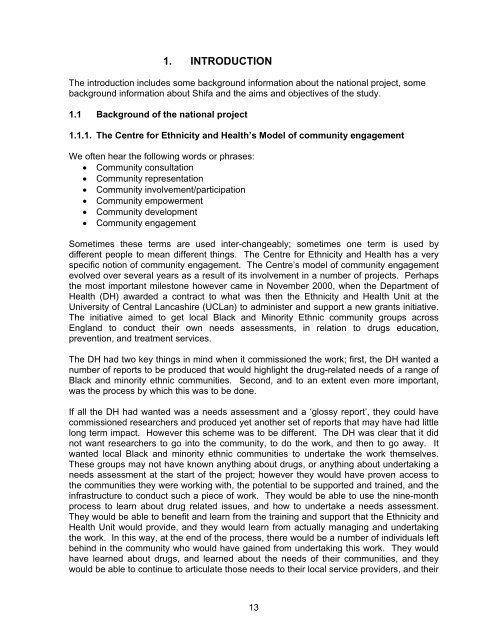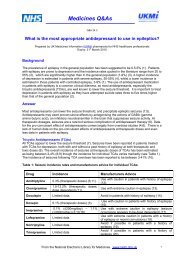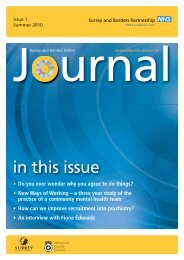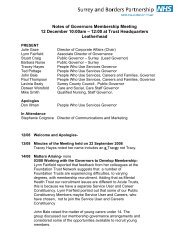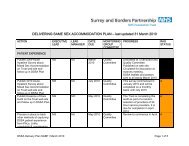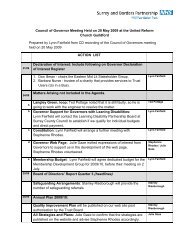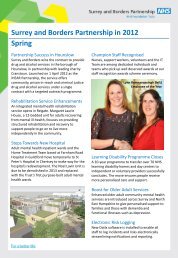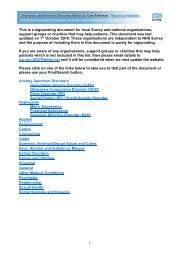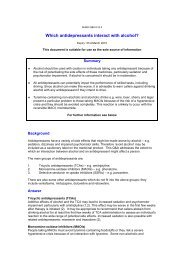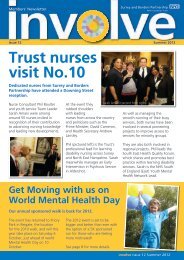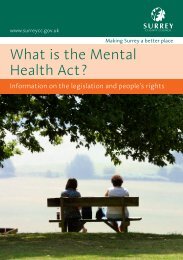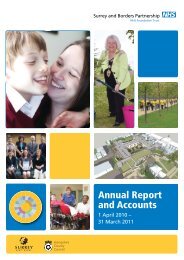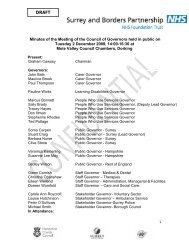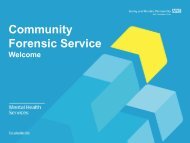Shifa Community Engagement Project Report - Surrey and Borders ...
Shifa Community Engagement Project Report - Surrey and Borders ...
Shifa Community Engagement Project Report - Surrey and Borders ...
Create successful ePaper yourself
Turn your PDF publications into a flip-book with our unique Google optimized e-Paper software.
1. INTRODUCTION<br />
The introduction includes some background information about the national project, some<br />
background information about <strong>Shifa</strong> <strong>and</strong> the aims <strong>and</strong> objectives of the study.<br />
1.1 Background of the national project<br />
1.1.1. The Centre for Ethnicity <strong>and</strong> Health’s Model of community engagement<br />
We often hear the following words or phrases:<br />
• <strong>Community</strong> consultation<br />
• <strong>Community</strong> representation<br />
• <strong>Community</strong> involvement/participation<br />
• <strong>Community</strong> empowerment<br />
• <strong>Community</strong> development<br />
• <strong>Community</strong> engagement<br />
Sometimes these terms are used inter-changeably; sometimes one term is used by<br />
different people to mean different things. The Centre for Ethnicity <strong>and</strong> Health has a very<br />
specific notion of community engagement. The Centre’s model of community engagement<br />
evolved over several years as a result of its involvement in a number of projects. Perhaps<br />
the most important milestone however came in November 2000, when the Department of<br />
Health (DH) awarded a contract to what was then the Ethnicity <strong>and</strong> Health Unit at the<br />
University of Central Lancashire (UCLan) to administer <strong>and</strong> support a new grants initiative.<br />
The initiative aimed to get local Black <strong>and</strong> Minority Ethnic community groups across<br />
Engl<strong>and</strong> to conduct their own needs assessments, in relation to drugs education,<br />
prevention, <strong>and</strong> treatment services.<br />
The DH had two key things in mind when it commissioned the work; first, the DH wanted a<br />
number of reports to be produced that would highlight the drug-related needs of a range of<br />
Black <strong>and</strong> minority ethnic communities. Second, <strong>and</strong> to an extent even more important,<br />
was the process by which this was to be done.<br />
If all the DH had wanted was a needs assessment <strong>and</strong> a ‘glossy report’, they could have<br />
commissioned researchers <strong>and</strong> produced yet another set of reports that may have had little<br />
long term impact. However this scheme was to be different. The DH was clear that it did<br />
not want researchers to go into the community, to do the work, <strong>and</strong> then to go away. It<br />
wanted local Black <strong>and</strong> minority ethnic communities to undertake the work themselves.<br />
These groups may not have known anything about drugs, or anything about undertaking a<br />
needs assessment at the start of the project; however they would have proven access to<br />
the communities they were working with, the potential to be supported <strong>and</strong> trained, <strong>and</strong> the<br />
infrastructure to conduct such a piece of work. They would be able to use the nine-month<br />
process to learn about drug related issues, <strong>and</strong> how to undertake a needs assessment.<br />
They would be able to benefit <strong>and</strong> learn from the training <strong>and</strong> support that the Ethnicity <strong>and</strong><br />
Health Unit would provide, <strong>and</strong> they would learn from actually managing <strong>and</strong> undertaking<br />
the work. In this way, at the end of the process, there would be a number of individuals left<br />
behind in the community who would have gained from undertaking this work. They would<br />
have learned about drugs, <strong>and</strong> learned about the needs of their communities, <strong>and</strong> they<br />
would be able to continue to articulate those needs to their local service providers, <strong>and</strong> their<br />
13


